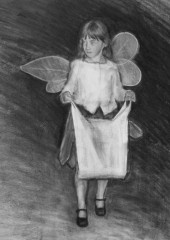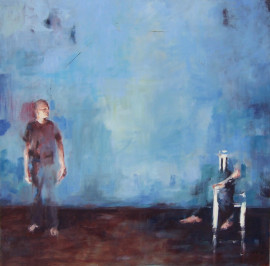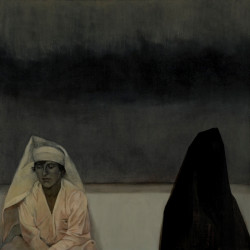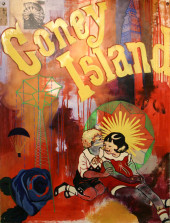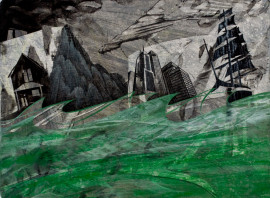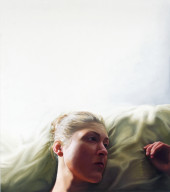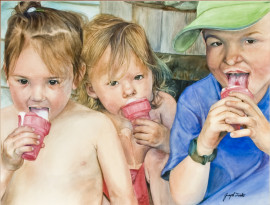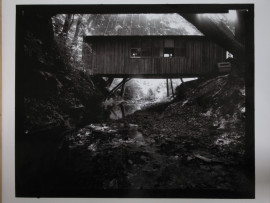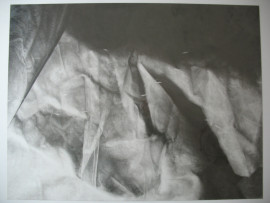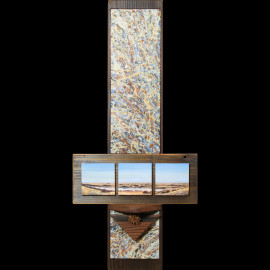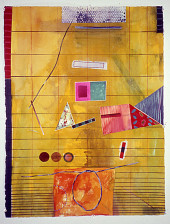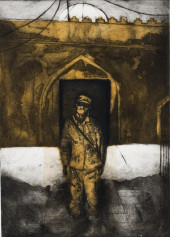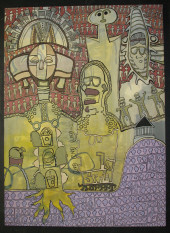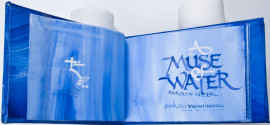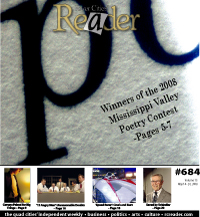 The Rock Island Fine Arts Exhibition, now in its 32nd year, is necessarily disparate, with a wide variety of media and artists. But that doesn't mean that themes don't emerge.
The Rock Island Fine Arts Exhibition, now in its 32nd year, is necessarily disparate, with a wide variety of media and artists. But that doesn't mean that themes don't emerge.
As River Cities' Reader art critic Bruce Carter said in discussing the exhibit, "There's always a pattern in every show."
David Alan Robertson, in his juror's statement, said his first criteria related to technical mastery, but a selected work needed to "transcend well established styles and seek wholly new approaches to its subject matter."
He also said in conversation that he was looking for works that showed the artists' confidence in their techique, and that addressed the human condition and the response to experience.
That process winnowed approximately 280 works to less than 50. Last week, River Cities' Reader art critics Carter and Steve Banks discussed nearly half the works in the show over the course of an hour. Excerpts from their conversation follow, and you can listen to or download the entire review here. Images of works discussed in the show can be found within and after the article.
Carter and Banks seemed particularly interested in Robertson's choice of works that feature obvious contrasts - diptychs, figures played in opposition to one another, round shapes set against rectangular ones.
The Rock Island Fine Arts Exhibition runs through April 27 at the Augustana College Art Museum, which is open from noon to 4 p.m. Tuesday through Sunday. The museum is located in Centennial Hall, on the northeast corner of Seventh Avenue and 38th Street in Rock Island.
Katie Kiley, Misstep (First Prize)
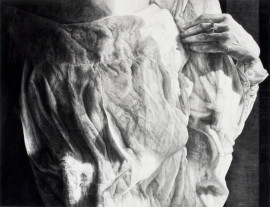 Banks: "Very soft light on the fabric. It helps brings out all the little textures without seeming obsessed or trying to get photographic reality captured, but more of the essence of the softness of the fabric."
Banks: "Very soft light on the fabric. It helps brings out all the little textures without seeming obsessed or trying to get photographic reality captured, but more of the essence of the softness of the fabric."
Carter: "Very interesting in that it's realistic yet also abstract; you can get lost in the folds. You really don't notice the line itself. All the lines add up to the image. There's like a little army of ants - the lines."
Banks: "You don't draw like this by accident. This takes years and years of familiarity with the medium."
Bruce Walters, New Laws (Honorable Mention)
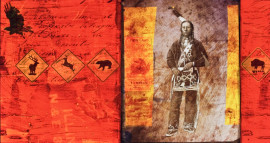 Banks: "Usually the deer-crossing signs are more of a warning to people that are foreign to that territory, people that are driving through. So I wonder with the Native American over on the right panel, if this is the creatures of his realm, or if this is actually a fifth sign: Beware of the Indian, just like the other animals that we'll hunt to extinction."
Banks: "Usually the deer-crossing signs are more of a warning to people that are foreign to that territory, people that are driving through. So I wonder with the Native American over on the right panel, if this is the creatures of his realm, or if this is actually a fifth sign: Beware of the Indian, just like the other animals that we'll hunt to extinction."
Carter: "I myself have a tough time sometimes with digital images. Do I read it like a photograph? Do I read it like a painting? On this one here, until I had settled into it after a while, I really didn't quite pick up on what it was doing."
Banks: "My guess is in five to 10 years, we're going to read them like digital images. It'll just be its own thing, and there won't be that 'Is this a painting or is this a photograph?' ... Those criteria don't really apply any more."
Banks: "I'm impressed and pleased to see that he's able to take that level of sensibility and sensitivity that he had in his drawings and show it in his digital work. This to me has more of that presence that his drawings did."
Joe Turek, C'mon Mom!
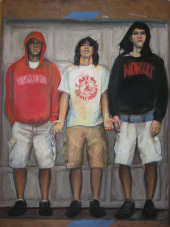 Banks: "A nice use of the geometric structure of a garage door behind to sort of separate how the figures lay out. Each head falls inside of a different panel, and it gives it just that little bit of geometric structure against those organic forms."
Banks: "A nice use of the geometric structure of a garage door behind to sort of separate how the figures lay out. Each head falls inside of a different panel, and it gives it just that little bit of geometric structure against those organic forms."
Carter: "And negative space, too. Almost like a medieval piece, with the balance things have. I love the unexpected play of color going through everything. It's realistic, and yet Joe is really playing with the images."
Susan Long, Kelly in the Rocking Chair
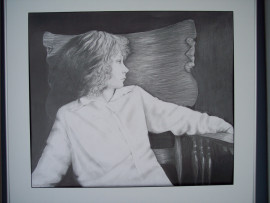 Carter: "An Andrew Wyeth kind of piece. Very quiet, very intense charcoal. Not as done in the shirt as strongly as others. The hair, nicely done - decorative Botticelli lines flowing off into the chair."
Carter: "An Andrew Wyeth kind of piece. Very quiet, very intense charcoal. Not as done in the shirt as strongly as others. The hair, nicely done - decorative Botticelli lines flowing off into the chair."
Banks: "The things that hop out to me right away is the darkness of the background contrasted with the light of the shirt. The arms form sort of a drooping T that leads you up to the face. The face is rendered very well, a lot of description to it, and then on either side, you have a loosely structured back of a chair, and then the hair starts to meld into the back of the chair, too. There's a quasi-photographic quality to the face, and then very much a drawing, linear sort of thing going on with the hair and the back of the chair, and then those elements leading you up, plus the white thrust of the body in general."
Christian Arrecis, Untitled (Second Prize)
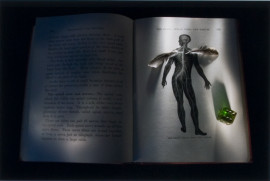 Banks: "The book naturally divides the image into sort of a diptych between the intellectual text and some sort of scientific drawing, but with these other elements layered on top becomes more than a drawing. It starts to almost become a small installation on the page."
Banks: "The book naturally divides the image into sort of a diptych between the intellectual text and some sort of scientific drawing, but with these other elements layered on top becomes more than a drawing. It starts to almost become a small installation on the page."
Banks: "If you block out just the green die and the light that it casts, that image doesn't have nearly as much going on. That's 3 to 5 percent of the total surface area, but without that, it sort of deflates the whole image."
Jessica Gondek, Pacifier (Oil Painting Award)
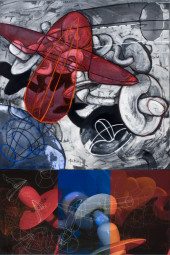 Carter: "The top part is intuition; the bottom part is reasoned and logical and sequential."
Carter: "The top part is intuition; the bottom part is reasoned and logical and sequential."
Banks: "If you look at the piece from the side, the top panel of the diptych - which is two and a half times as long as the bottom - has all kinds of textures and imprecise lines, whereas the bottom is much more about precision and smoothness and roundness."
Corrine Smith, Anew #28
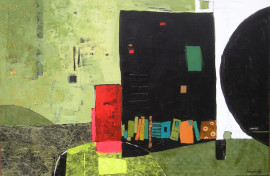 Carter: "This is very landscape-y for Corrine. Corrine's pieces were flat. You look down on them. This one here, there's a sense of going back. Textured paper, a large black building, kind of a boulder, a little abstract form. This looks like a place you could go. A little door back here, and they probably serve good pasta. And over here is a place you can get olive oil. And here's the fields over here, and this hill rising up. That Matisse-y flatness is going away."
Carter: "This is very landscape-y for Corrine. Corrine's pieces were flat. You look down on them. This one here, there's a sense of going back. Textured paper, a large black building, kind of a boulder, a little abstract form. This looks like a place you could go. A little door back here, and they probably serve good pasta. And over here is a place you can get olive oil. And here's the fields over here, and this hill rising up. That Matisse-y flatness is going away."
Banks: "The color interactions are exciting. There's a whole bunch of things going on that you could see the roots of in earlier pieces, but she hadn't quite done yet."
Diane Bruce, Repose
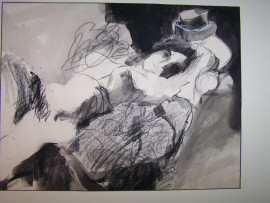 Carter: "Very abstract, barely touching the real, and yet you get a sense of the figure lying there. Almost the minimum amount of information necessary to register a figure."
Carter: "Very abstract, barely touching the real, and yet you get a sense of the figure lying there. Almost the minimum amount of information necessary to register a figure."
Banks: "Although things are not overly described, they're appropriately described. If she'd spent another five hours on this, finely rendering a navel, it would have added nothing to the piece, and more than likely would have taken something from it. This is a very loose, natural pose, and if you squint your eyes and look at it real quick, it's a nice interaction between light shapes and dark shapes, positive and negative - things you would stress in a beginning drawing class or a beginning design class. A very natural execution of it."
Other Works Discussed in the Audio Commentary
Bruce Walters, Halloween Series Drawing
Erik Ohrn, Common Occurrence
Genevieve Lawrence, Two Nurses
Heidi Hernandez, Coney Island
Jeff Tady, Sea Change
Jessica Rebick, Untitled
Joe Turek, Three Kids Eating Ice Cream
John Deason, Remains of an Iron Ore Stamp Mill on Lake Superior at Gay Michigan
Katie Kiley, Untitled
Lisa Higby LeFevre, The Transcendence of Stillness
Robert Lee Mejer, Windowscape Revisited
Scott Lenaway, Jason
Steve Banks, Carnival
William Hannan, A Muse of Water

